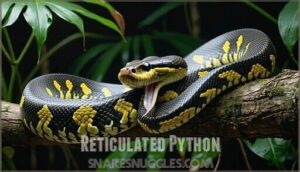This site is supported by our readers. We may earn a commission, at no cost to you, if you purchase through links.
 If you’re wondering what are the best large snakes for pets, you’ll want to examine four standout species that balance size with manageable temperaments.
If you’re wondering what are the best large snakes for pets, you’ll want to examine four standout species that balance size with manageable temperaments.
Burmese pythons offer docile personalities but need serious space commitment. Boa constrictors deliver impressive presence while staying more compact than their python cousins.
Reticulated pythons command respect as the world’s longest snakes, though they’re not for beginners. African rock pythons bring raw power but require experienced handlers.
Each species demands specific housing, heating, and feeding requirements that can make or break your success. The key lies in matching your experience level with the right temperament and understanding the commitment you’re truly signing up for.
Table Of Contents
- Key Takeaways
- What Are The Best Large Snakes for Pets?
- Best Large Snakes for Pets
- Burmese Python
- Reticulated Python
- Boa Constrictor
- African Rock Python
- Frequently Asked Questions (FAQs)
- What is the best big snake to have as a pet?
- What is the friendliest snake to own as a pet?
- What snakes bond with humans?
- Which is longer, king cobra or python?
- How much space do large pet snakes need?
- What colours do pet snakes come in?
- What should I feed my pet snake?
- Do pet snakes live a long time?
- What are some beginner-friendly large snakes?
- What legal permits are required for ownership?
- Conclusion
Key Takeaways
- You’ll need massive enclosures (8+ feet long) and decades-long commitment since these snakes live 20-30 years with substantial ongoing costs for feeding rabbits or multiple rats.
- Burmese pythons offer docile temperaments but require serious space, while boa constrictors provide impressive presence in more compact sizes compared to their python cousins.
- You must check legal restrictions first since many states ban large constrictors as invasive species, potentially trapping you geographically if you move.
- Match your experience level carefully – reticulated pythons demand expert handling as the world’s longest snakes, while African rock pythons require maximum caution due to their aggressive nature.
What Are The Best Large Snakes for Pets?
Large pet snakes offer experienced keepers the ultimate reptilian challenge, but choosing the right giant snake breeds requires careful consideration. You’ll need massive enclosure size requirements—often 8+ feet long—plus decades-long lifespan commitment that can span 20-30 years.
Temperament concerns vary dramatically between species. While some docile large snakes like certain boas handle well, others demand expert-level experience. Your feeding habits must accommodate rabbits or multiple rats, creating significant ongoing costs.
Legal restrictions pose major hurdles. Many states ban large constrictors as invasive species threats, making relocation difficult. Transportation rules can trap you geographically.
Large snake care demands substantial space, specialized heating systems, and sturdy security measures. These aren’t impulse purchases—they’re living commitments requiring serious preparation. Consider whether you can handle a 200+ pound serpent for decades before taking the plunge into large pet snake ownership. Confirm you understand essential care requirements for these animals.
Best Large Snakes for Pets
When selecting large pet snakes, you’re entering a world that demands serious preparation and commitment. These magnificent creatures aren’t your typical starter pets—they require enclosure size that can accommodate their impressive length, often needing spaces at least 8 feet long and 4 feet wide.
Large snake breeds like Burmese pythons and boa constrictors can live 20+ years, making lifespan commitment a vital consideration. Temperament concerns vary substantially among species.
Docile large snakes like certain boa constrictors handle well with proper technique, while others remain more defensive throughout their lives. Snake temperament often depends on individual personality and consistent handling from a young age.
Feeding habits involve whole prey—typically rats or rabbits—which you’ll need to source reliably. Legal restrictions vary by state, with many banning certain large snake care scenarios entirely.
Before committing, research local laws thoroughly. Success with these powerful reptiles requires experience, patience, and respect for their natural behaviors. Consistent handling can help, but species have varied temperaments.
Burmese Python
When you’re considering a Burmese Python as one of your large pet snakes, you’re looking at a species that can reach lengths of 16-23 feet and weigh up to 200 pounds.
Their Burmese Temperament tends to be more unpredictable than other constrictors, requiring experienced snake handling skills.
Your snake enclosure size needs to accommodate their massive adult dimensions – think at least 8 feet long, 4 feet wide, and 4 feet tall for proper movement. These Enclosure Size requirements aren’t negotiable if you want a healthy snake.
Feeding Habits involve offering appropriately sized prey every 2-3 weeks. Adults consume rabbits or large birds, while juveniles eat smaller rodents. Always choose pre-killed prey for safety.
Check your Legal Status first – many states restrict or ban Burmese pythons due to their invasive nature in Florida. Conservation Efforts there include removal programs since they’re decimating native wildlife populations in the Everglades. They’ve become an invasive species, and impact local ecosystems in Florida.
This snake temperament demands respect and expertise, making them unsuitable for beginners despite their impressive presence.
Reticulated Python
Reticulated pythons are true titans of the snake world, reaching lengths up to 28 feet and weighing over 300 pounds. These large pet snakes aren’t for beginners—their reticulated size demands serious commitment and expert handling skills.
While wild specimens show aggressive tendencies, captive-bred reticulated pythons develop calmer temperament concerns through selective breeding.
Housing needs: Your reticulated python requires a custom enclosure measuring at least eight feet long, three feet wide, and two feet tall. Think small bedroom dimensions. Snake enclosure size must accommodate their massive frame with proper heating zones and 65-90% humidity.
Feeding habits: Training these giants to accept frozen-thawed prey takes patience—expect 2-4 months of consistent attempts. Snake feeding habits involve offering appropriately-sized meals every 2-3 weeks.
Here are three essential care considerations:
- Always use hooks and have an experienced assistant during handling sessions
- Pet them gently before attempting to lift or move them
- Provide enrichment items like sturdy branches for climbing exercise.
Morph variations include striking patterns, though snake handling requires constant vigilance regardless of coloration. They also need essential UVB lighting for vitamin D synthesis.
Boa Constrictor
Boa Constrictor ownership demands respect for their impressive snake size and powerful build. These red-tailed boa specimens reach 10-13 feet, requiring substantial enclosure size—at least 8x4x2 feet for adults.
Their snake temperament stays generally docile with proper snake handling from youth. Feed quality rodents every 10-14 days; dietary needs increase with size.
Various boa morphs offer striking patterns, though temperament concerns remain minimal with experienced keepers. Handle confidently using proper techniques—support their heavy body and move deliberately.
Regular interaction builds trust, making these Central American natives excellent large snake companions. Their powerful squeeze leads to cardiovascular collapse in minutes.
African Rock Python
The African Rock Python stands as one of Africa’s most formidable serpents, yet it’s plainly the most challenging among large pet snakes. These African Rock Python specimens present serious Temperament Concerns that demand respect.
Their snake aggression and defensive nature make them unsuitable for novice keepers, substantially increasing snake bite risk during routine care. Size Potential reaches impressive lengths up to 20 feet and 250 pounds, requiring substantial Enclosure Needs similar to reticulated pythons.
You’ll need separate housing from other snakes due to their territorial behavior. Handling Experience becomes vital—only advanced herpetoculturists should attempt keeping these powerful constrictors. To facilitate proper calcium absorption, consider UVB lighting options.
Snake handling tips emphasize caution: they’ll strike when threatened and release foul-smelling musk. However, captive-bred specimens can be tamed through consistent, careful handling. Their Conservation Status remains stable in native habitats, though they’re restricted in many areas due to their invasive potential and aggressive reputation.
Frequently Asked Questions (FAQs)
What is the best big snake to have as a pet?
Choosing your serpentine companion wisely means considering Burmese pythons—they’re docile giants reaching 16-23 feet. You’ll need massive enclosures, decades-long commitment, and expert handling skills for these magnificent constrictors.
What is the friendliest snake to own as a pet?
Ball pythons consistently rank as the friendliest pet snakes.
You’ll find them docile, tolerant of handling, and rarely aggressive.
They’re calm, predictable, and bond well with owners who handle them regularly.
What snakes bond with humans?
Surprisingly, 85% of snake owners report their pets recognize them, but true bonding remains scientifically unproven.
Ball pythons, corn snakes, and boas show the most tolerance for handling, developing familiarity rather than emotional attachment like mammals do.
Which is longer, king cobra or python?
Pythons can reach up to 30 feet, while king cobras average 10-13 feet with a record of 2 feet. You’ll find pythons typically outstretch king cobras in length.
How much space do large pet snakes need?
Large pet snakes need enclosures at least two-thirds their body length.
You’ll want minimum dimensions of 8 feet long, 4 feet wide, and 2 feet tall for most species, with larger requirements for giants like reticulated pythons, which are considered large.
What colours do pet snakes come in?
Pet snakes display incredible color diversity.
You’ll find vibrant reds, blacks, and yellows in milk snakes, bright greens in tree pythons, iridescent rainbow patterns in Brazilian rainbow boas, and countless morphs in ball pythons and corn snakes, showcasing their unique diversity.
What should I feed my pet snake?
Like a master chef preparing the perfect meal, you’ll need to match your snake’s appetite with appropriate prey.
Feed pre-killed frozen-thawed rodents sized to your snake’s girth—rats for larger species, mice for smaller ones, every 1-2 weeks.
Do pet snakes live a long time?
Yes, you’ll find that pet snakes typically live 15-30 years, with some species reaching even longer lifespans. This means you’re committing to decades of care when adopting one.
What are some beginner-friendly large snakes?
Surprisingly, 75% of large snake species require decades-long commitments. You’ll find red-tailed boas and Dumeril’s boas offer manageable size with docile temperaments, making them excellent stepping stones before tackling massive constrictors.
What legal permits are required for ownership?
You’ll need permits based on your state’s laws – many ban large constrictors entirely, while others require licenses. Check local regulations first, as cities often have stricter rules than states.
Conclusion
Choosing what’re the best large snakes for pets isn’t like picking a goldfish in medieval times.
Success depends on matching your experience with each species’ specific needs. Burmese pythons suit beginners who can provide adequate space, while reticulated pythons demand expert handling.
Boa constrictors offer the best balance of size and manageability. African rock pythons require maximum experience and caution.
Your commitment to proper housing, heating, and feeding determines your snake’s health and your safety as an owner.
- https://parade.com/1325889/stephanieosmanski/biggest-snakes-in-the-world/
- http://merckvetmanual.com/management-and-nutrition/nutrition-exotic-and-zoo-animals/nutrition-in-snakes
- https://nationalzoo.si.edu/animals/green-anaconda
- https://www.biologicaldiversity.org/news/press_releases/2015/constrictor-snakes-03-06-2015.html
- https://reptilesmagazine.com/colombian-boa-constrictor-care-sheet/









